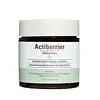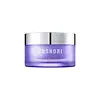What's inside
What's inside
 Key Ingredients
Key Ingredients

 Benefits
Benefits

 Concerns
Concerns

No concerns
 Ingredients Side-by-side
Ingredients Side-by-side

Hydrogenated Polydecene
EmollientCetearyl Alcohol
EmollientNiacinamide
Smoothing1,2-Hexanediol
Skin ConditioningEctoin
Skin ConditioningPanthenol
Skin ConditioningCetearyl Glucoside
EmulsifyingGlyceryl Stearate
EmollientPentylene Glycol
Skin ConditioningPolymethylsilsesquioxane
C12-16 Alcohols
EmollientPalmitic Acid
EmollientButylene Glycol
HumectantHydrogenated Lecithin
EmulsifyingCarbomer
Emulsion StabilisingTromethamine
BufferingRaffinose
Skin ConditioningStearic Acid
CleansingCaprylyl Glycol
EmollientSodium Acrylate/Sodium Acryloyldimethyl Taurate Copolymer
Emulsion StabilisingCaramel
Cosmetic ColorantPolyisobutene
Ethylhexylglycerin
Skin ConditioningAdenosine
Skin ConditioningCaprylyl/Capryl Glucoside
CleansingSorbitan Oleate
EmulsifyingDisodium EDTA
Hydrolyzed Hibiscus Esculentus Extract
Skin ConditioningLupinus Albus Seed Extract
Skin ConditioningMoringa Oleifera Seed Extract
Skin ConditioningCeramide NP
Skin ConditioningCholesterol
EmollientCholeth-24
EmulsifyingDipropylene Glycol
HumectantHydrolyzed Hyaluronic Acid
HumectantStreptococcus Thermophilus Ferment
HumectantMilk Protein Extract
Serine
MaskingGlycine
BufferingHistidine
HumectantArginine
MaskingLecithin
EmollientHydrolyzed Collagen
EmollientDipotassium Glycyrrhizate
HumectantMagnesium PCA
HumectantCopper Tripeptide-1
Skin ConditioningSucrose
HumectantCalcium Chloride
AstringentOrnithine
Skin ConditioningSea Salt
AbrasiveAlanine
MaskingMagnesium Chloride
Threonine
Aspartic Acid
MaskingValine
MaskingProline
Skin ConditioningDipotassium Phosphate
BufferingLysine
Skin ConditioningLeucine
Skin ConditioningTyrosine
MaskingIsoleucine
Skin ConditioningMagnesium Citrate
Skin ConditioningGlucosamine Hcl
Phenylalanine
MaskingGlutamic Acid
Humectant1-Methylhydantoin-2-Imide
Skin ConditioningAsparagine
MaskingCitrulline
Skin ConditioningMethionine
Skin ConditioningTaurine
BufferingTryptophan
MaskingFormic Acid
PreservativeGlutamine
Skin ConditioningCysteine
AntioxidantHydrogenated Polydecene, Cetearyl Alcohol, Niacinamide, 1,2-Hexanediol, Ectoin, Panthenol, Cetearyl Glucoside, Glyceryl Stearate, Pentylene Glycol, Polymethylsilsesquioxane, C12-16 Alcohols, Palmitic Acid, Butylene Glycol, Hydrogenated Lecithin, Carbomer, Tromethamine, Raffinose, Stearic Acid, Caprylyl Glycol, Sodium Acrylate/Sodium Acryloyldimethyl Taurate Copolymer, Caramel, Polyisobutene, Ethylhexylglycerin, Adenosine, Caprylyl/Capryl Glucoside, Sorbitan Oleate, Disodium EDTA, Hydrolyzed Hibiscus Esculentus Extract, Lupinus Albus Seed Extract, Moringa Oleifera Seed Extract, Ceramide NP, Cholesterol, Choleth-24, Dipropylene Glycol, Hydrolyzed Hyaluronic Acid, Streptococcus Thermophilus Ferment, Milk Protein Extract, Serine, Glycine, Histidine, Arginine, Lecithin, Hydrolyzed Collagen, Dipotassium Glycyrrhizate, Magnesium PCA, Copper Tripeptide-1, Sucrose, Calcium Chloride, Ornithine, Sea Salt, Alanine, Magnesium Chloride, Threonine, Aspartic Acid, Valine, Proline, Dipotassium Phosphate, Lysine, Leucine, Tyrosine, Isoleucine, Magnesium Citrate, Glucosamine Hcl, Phenylalanine, Glutamic Acid, 1-Methylhydantoin-2-Imide, Asparagine, Citrulline, Methionine, Taurine, Tryptophan, Formic Acid, Glutamine, Cysteine
Terminalia Ferdinandiana Fruit Extract
AntioxidantWater
Skin ConditioningPanthenol 10%
Skin ConditioningButylene Glycol
HumectantPentylene Glycol
Skin ConditioningGlycerin
HumectantHydrogenated Polydecene
EmollientNiacinamide
Smoothing1,2-Hexanediol
Skin ConditioningAmmonium Acryloyldimethyltaurate/Vp Copolymer
Polyglyceryl-3 Methylglucose Distearate
EmulsifyingArginine
MaskingCarbomer
Emulsion StabilisingArgania Spinosa Kernel Oil
EmollientSqualane
EmollientCeramide NP
Skin ConditioningBetaine
HumectantEthylhexylglycerin
Skin ConditioningGlyceryl Acrylate/Acrylic Acid Copolymer
HumectantAdenosine
Skin ConditioningDisodium EDTA
Sodium Hyaluronate
HumectantMadecassoside
AntioxidantCentella Asiatica Leaf Extract
Skin ConditioningAsiaticoside
AntioxidantTerminalia Ferdinandiana Fruit Extract, Water, Panthenol 10%, Butylene Glycol, Pentylene Glycol, Glycerin, Hydrogenated Polydecene, Niacinamide, 1,2-Hexanediol, Ammonium Acryloyldimethyltaurate/Vp Copolymer, Polyglyceryl-3 Methylglucose Distearate, Arginine, Carbomer, Argania Spinosa Kernel Oil, Squalane, Ceramide NP, Betaine, Ethylhexylglycerin, Glyceryl Acrylate/Acrylic Acid Copolymer, Adenosine, Disodium EDTA, Sodium Hyaluronate, Madecassoside, Centella Asiatica Leaf Extract, Asiaticoside
 Reviews
Reviews

Ingredients Explained
These ingredients are found in both products.
Ingredients higher up in an ingredient list are typically present in a larger amount.
1,2-Hexanediol is a synthetic liquid and another multi-functional powerhouse.
It is a:
- Humectant, drawing moisture into the skin
- Emollient, helping to soften skin
- Solvent, dispersing and stabilizing formulas
- Preservative booster, enhancing the antimicrobial activity of other preservatives
Adenosine is in every living organism. It is one of four components in nucleic acids that helps store our DNA.
Adenosine has many benefits when used. These benefits include hydrating the skin, smoothing skin, and reducing wrinkles. Once applied, adenosine increases collagen production. It also helps with improving firmness and tissue repair.
Studies have found adenosine may also help with wound healing.
In skincare products, Adenosine is usually derived from yeast.
Learn more about AdenosineArginine is an amino acid that is important for human development. Your body uses is it to produce hair keratin and skin collagen.
As a cosmetic ingredient, Arginine has antioxidant properties and can also help repair damaged skin. This ingredient is derived either synthetically or from animals.
Arginine isn't fungal acne safe when used in the presence of other lipids (fats, fatty acids, oils, esters, etc). Oils and fats occur naturally within the skin, so take caution when using Arginine if you're prone to fungal acne.
Learn more about ArginineButylene Glycol (or BG) is used within cosmetic products for a few different reasons:
Overall, Butylene Glycol is a safe and well-rounded ingredient that works well with other ingredients.
Though this ingredient works well with most skin types, some people with sensitive skin may experience a reaction such as allergic rashes, closed comedones, or itchiness.
Learn more about Butylene GlycolCarbomer is a polymer of acrylic acid. Its main role is to create a gel consistency.
A high amount of carbomer can cause pilling or balling up of products. Don't worry, most products contain 1% or less of carbomer.
Ceramide NP is a type of ceramide and formally known as ceramide 3.
Ceramides are intercellular lipids naturally found in our skin that bonds dead skin cells together to create a barrier. They are known for their ability to hold water and thus are a great ingredient for dry skin.
Ceramides are an important building block for our skin barrier. A stronger barrier helps the skin look more firm and hydrated. By bolstering the skin ceramides act as a barrier against irritating ingredients. This can help with inflammation as well.
If you would like to eat ceramides, sweet potatoes contain a small amount.
Read more about other common types of ceramides here:
Ceramide AP
Ceramide EOP
Disodium EDTA plays a role in making products more stable by aiding other preservatives.
It is a chelating agent, meaning it neutralizes metal ions that may be found in a product.
Disodium EDTA is a salt of edetic acid and is found to be safe in cosmetic ingredients.
Learn more about Disodium EDTAEthylhexylglycerin (we can't pronounce this either) is commonly used as a preservative and skin softener. It is derived from glyceryl.
You might see Ethylhexylglycerin often paired with other preservatives such as phenoxyethanol. Ethylhexylglycerin has been found to increase the effectiveness of these other preservatives.
Hydrogenated Polydecene is an emollient. It creates a non-occlusive film on the skin that offers extra protection for your skin barrier.
The texture of Hydrogenated Polydecene ranges from light and silky to rich.
Hydrogenated Polydecene is the end compound of controlled hydrogenation of Polydecene.
Learn more about Hydrogenated PolydeceneNiacinamide is a multitasking form of vitamin B3 that strengthens the skin barrier, reduces pores and dark spots, regulates oil, and improves signs of aging.
And the best part? It's gentle and well-tolerated by most skin types, including sensitive and reactive skin.
You might have heard of "niacin flush", or the reddening of skin that causes itchiness. Niacinamide has not been found to cause this.
In very rare cases, some individuals may not be able to tolerate niacinamide at all or experience an allergic reaction to it.
If you are experiencing flaking, irritation, and dryness with this ingredient, be sure to double check all your products as this ingredient can be found in all categories of skincare.
When incorporating niacinamide into your routine, look out for concentration amounts. Typically, 5% niacinamide provides benefits such as fading dark spots. However, if you have sensitive skin, it is better to begin with a smaller concentration.
When you apply niacinamide to your skin, your body converts it into nicotinamide adenine dinucleotide (NAD). NAD is an essential coenzyme that is already found in your cells as "fuel" and powers countless biological processes.
In your skin, NAD helps repair cell damage, produce new healthy cells, support collagen production, strengthen the skin barrier, and fight environmental stressors (like UV and pollution).
Our natural NAD levels start to decline with age, leading to slower skin repair, visible aging, and a weaker skin barrier. By providing your skin niacinamide, you're recharging your skin's NAD levels. This leads to stronger, healthier, and younger looking skin.
Another name for vitamin B3 is nicotinamide. This vitamin is water-soluble and our bodies don't store it. We obtain Vitamin B3 from either food or skincare. Meat, fish, wheat, yeast, and leafy greens contain vitamin B3.
The type of niacinamide used in skincare is synthetically created.
Learn more about NiacinamidePanthenol is a common ingredient that helps hydrate and soothe the skin. It is found naturally in our skin and hair.
There are two forms of panthenol: D and L.
D-panthenol is also known as dexpanthenol. Most cosmetics use dexpanthenol or a mixture of D and L-panthenol.
Panthenol is famous due to its ability to go deeper into the skin's layers. Using this ingredient has numerous pros (and no cons):
Like hyaluronic acid, panthenol is a humectant. Humectants are able to bind and hold large amounts of water to keep skin hydrated.
This ingredient works well for wound healing. It works by increasing tissue in the wound and helps close open wounds.
Once oxidized, panthenol converts to pantothenic acid. Panthothenic acid is found in all living cells.
This ingredient is also referred to as pro-vitamin B5.
Learn more about PanthenolPentylene glycol is typically used within a product to thicken it. It also adds a smooth, soft, and moisturizing feel to the product. It is naturally found in plants such as sugar beets.
The hydrophilic trait of Pentylene Glycol makes it a humectant. As a humectant, Pentylene Glycol helps draw moisture from the air to your skin. This can help keep your skin hydrated.
This property also makes Pentylene Glycol a great texture enhancer. It can also help thicken or stabilize a product.
Pentylene Glycol also acts as a mild preservative and helps to keep a product microbe-free.
Some people may experience mild eye and skin irritation from Pentylene Glycol. We always recommend speaking with a professional about using this ingredient in your routine.
Pentylene Glycol has a low molecular weight and is part of the 1,2-glycol family.
Learn more about Pentylene Glycol